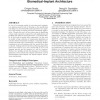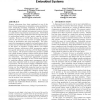113
Voted
CODES
2008
IEEE
15 years 22 days ago
2008
IEEE
With power becoming a major constraint for multi-processor embedded systems, it is becoming important for designers to characterize and model processor power dissipation. It is cr...
135
Voted
CODES
2008
IEEE
15 years 2 months ago
2008
IEEE
It is well recognized that novel computational models, devices and technologies are needed in order to sustain the remarkable advancement of CMOS-based VLSI circuits and systems. ...
117
Voted
CODES
2008
IEEE
15 years 2 months ago
2008
IEEE
In view of a booming market for microelectronic implants, our ongoing research work is focusing on the specification and design of a novel biomedical microprocessor core targeting...
124
Voted
CODES
2008
IEEE
15 years 2 months ago
2008
IEEE
As the importance of multimedia applications in hand-held devices increases, the computational strain and corresponding demand for energy in such devices continues to grow. Portab...
118
Voted
CODES
2008
IEEE
15 years 2 months ago
2008
IEEE
Synchronous languages like Esterel have been widely adopted for designing reactive systems in safety-critical domains such as avionics. Specifications written in Esterel are based...
114
Voted
CODES
2008
IEEE
15 years 2 months ago
2008
IEEE
We study the problem of scheduling repetitive real-time tasks with the Earliest Deadline First (EDF) policy that can guarantee the given maximal temperature constraint. We show th...
101
Voted
CODES
2008
IEEE
15 years 2 months ago
2008
IEEE
Functional validation is a major bottleneck in microprocessor design methodology. Simulation is the widely used method for functional validation using billions of random and biase...
126
Voted
CODES
2008
IEEE
15 years 2 months ago
2008
IEEE
SystemC is widely used for modeling and simulation in hardware/software co-design. Due to the lack of a complete formal semantics, it is not possible to verify SystemC designs. In...
92
Voted
CODES
2008
IEEE
15 years 2 months ago
2008
IEEE
We present a system-level technique to analyze the impact of design optimizations on system-level timing dependencies. This technique enables us to speed up the design cycle by su...
162
Voted
CODES
2008
IEEE
15 years 2 months ago
2008
IEEE
Memory subsystems have been considered as one of the most critical components in embedded systems and furthermore, displaying increasing complexity as application requirements div...




